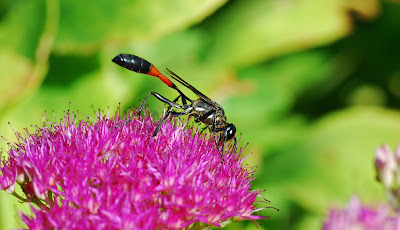This large unusual looking wasp is called a Thread-Waisted Wasp (Ammophila maculiventris). This particular specimen measured 1 1/2 inches. They are found throughout North America in a variety of habitats, including meadows, prairies, backyard gardens and anywhere else that flowers can be found. The adults dine on nectar and pollen from many types of flowers, like the sedum pictured here. This late in the year it is slim pickin's as far as flowering plants go in Missouri. The air is changing dramatically and from all the changes I've been seeing it is only matter of time before the first frost hits. Once that happens about the only insect activity we will see is the Multi-Colored Asian Lady Beetles and the Boxelder Bugs. All these unusual wasps will disappear. I wonder where they go? Do they hibernate in a state torpor? Do they perish and leave behind eggs to hatch the following spring? Do the larvae overwinter, and emerge as adults once warm weather returns? I could not find any information to answer those questions. If anyone knows, please comment.
These are solitary wasps, which basically means they do not rely on a hive or colony for their survival. After mating, the females will dig a shallow depression in the soil. She will then seek a caterpillar, that she stings to paralyze it. Flying back to the burrow she created, carrying the paralyzed caterpillar, she will deposit it in the hole and lay an egg on it. Once the egg hatches the young wasp larvae will begin feeding on the caterpillar provided by its parent. It takes several weeks for the wasp larvae to consume the entire caterpillar, once it has the larvae will pupate and emerge later in the summer as a full fledged adult. These wasps are expert hunters, and are designed with carrying large prey (caterpillars) in mind. They resemble the Sikorsky Skycrane Helicopter.


Beautiful photography as usual! I have a question for you about an entirely different insect. This weekend we finally saw our first huge swarm of crane flies. Do you get crane flies in MO? Have you ever photographed them and posted a blog about them? What information can you share with me about this insect that shows up in droves every fall in Ohio? Thanks!
ReplyDeleteThank you for your kind comments. Crane flies are very plentiful here in Missouri as well. We affectionately call them Missouri Mosquitoes! I posted a blog several months back, here is the link http://mobugs.blogspot.com/2009/05/missouri-mosquito.html
ReplyDeleteHope this helps :o)
Nice shot of the Thread-Waisted Wasp. They are one of the more interesting airborne insects.
ReplyDeleteI know that in paper wasps, only fertilized females overwinter. I suspect that adult solitary wasps die off during the cold weather leaving their larvae to emerge in the spring, but I do not know that for a fact.
I hope you don't mind me intruding upon the Crane Fly question, but the Carnegie Museum of Natural History has the most extensive Crane Fly site I've found.
Thanks Marvin,thread-waisted wasps seem to be always on the move and very difficult to photograph. It took many attempts to get this picture.
ReplyDeleteThat they die over winter would make sense, I just wonder when the brood is born in the summer, do they immediately lay eggs then perish?
I do not mind at all that you provided such an interesting website for McLibrarian. I'm sure she appreciates it....I know I do. I had not previously seen this site, thank you for sharing it with us.